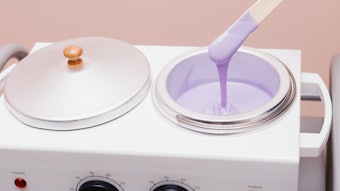Sensitive skin is common and on the rise! An estimated 44.6% of Americans claim to have sensitive or extremely sensitive skin.1 The numbers of women who believe their skin to be sensitive have risen 4% from 44% in 2015 to 48% in 2017.2 That means close to half of your total clients may have sensitive skin.
Waxing sensitive skin requires cautionary steps to complete a successful waxing service. When it comes to waxing, it is important to understand skin conditions to be able to identify sensitive skin. Equally important is differentiating between sensitive skin and contraindications to waxing services, as the two often become blurred together. It is imperative to analyze the skin, know the right questions to ask and know how to proceed in the waxing service. Is the client’s skin thin, compromised, sensitive or sensitized? Is the skin flaky due to dryness or cell turnover from a retinol serum or eczema? How do you differentiate between truly sensitive skin and a client who has been using a prescription acne product that she didn’t mention to you, or more importantly, you didn’t ask about? If your client has sensitive skin, regardless of the reason behind it, you need to know how to proceed with caution or not to proceed at all. Knowing you have made the right professional decisions will lead to positive results for the client and leave you feeling proud of your work.
What is Sensitive Skin?
Sensitive skinsensitive skin
Skin Types and Conditions
There are three skin types: normal, dry and oily. Combination skin is a combination of these—i.e., dry skin on the cheeks combined with oily areas on the forehead, nose and chin.
Skin conditions include acne, dehydrated skin, hyperpigmentation, aging skin, rosacea and sensitive skin. Any skin type can have acne, just as any skin type can be sensitive. Sensitive skin is a skin condition, not a skin type. Skin type is determined by your genetics and is part of your DNA. You are born with a specific skin type.
On the other hand, skin conditions are determined by internal factors and external factors, with some skin conditions, like eczema, also potentially being caused by genetics. Internal factors may include diet, hormonal changes or medications. External factors may include climate, sun exposure, pollution or skin care products. For example, facial scrubs and over-exfoliation commonly lead to over sensitized skin. Genetic factors may include genetic predisposition to rosacea, eczema or psoriasis.
Skin Sensitization
The acid mantle barrier of the skin is a thin film that is present in the skin’s outer layer, or the epidermis. It protects, balances the pH and helps retain moisture in the skin. If the acid mantle barrier becomes damaged due to any internal or external factors, the skin is susceptible to becoming over-sensitized. The nerve endings are left unprotected, and sensitive and dry skin results.
Over-exfoliation is a common cause in damaging the acid mantle barrier. With the increase of skin care products containing exfoliating ingredients like salicylic and glycolic acid and retinols and the use of scrubs, clients can overdo it leading to over-sensitized skin. Over-sensitized skin may be red, warm to the touch, and tender. Sometimes, tiny red bumps result from over-exfoliation. Clients may then exfoliate even more to try and smooth out the bumps, causing the skin to be even more sensitive. Thus, the endless cycle of sensitivity has begun.
Be Careful With Actives
Don’t be afraid of active ingredients for skin preservation or skin issues. Skin care products that have ingredients with exfoliating properties will cause the cells on the skin to turn over quicker or slough off faster. These ingredients are great for acne, smoothing fine lines, or lightening hyperpigmentation, but the skin will be thinner and more sensitive to waxing. Ingredients like salicylic acid, glycolic acid, retinol or vitamin C are contraindications to waxing, but this doesn’t mean clients must choose between clear skin and waxing.
The strength of the product will determine how long to discontinue it prior to waxing—usually 48 hours or more. For stronger prescriptions, discontinuing use for a week may be advisable. The client should always check with their doctor. Isotretinoin must be discontinued for at least six months, but a year is your best bet. Even then, some people will be too sensitive to wax ever again.
Isotretinoin is a contraindication for waxing anywhere on the body. Other products are contraindications for only the area the product is used on. However, be mindful of how products travel on the skin. This means that if a client uses a glycolic acid serum on their chin, this will also affect their eyebrows. Always clarify, asking if the client is using these ingredients anywhere on their face or body. Many ingrown hair products have ingredients like salicylic or glycolic acid, causing the skin to become sensitive to waxing.
Sensitive Skin Hair Removal
With so many reasons for sensitive skin, estheticians and clients may be feeling confused. Keep it simple! First, identify a client with sensitive skin (see Sensitive Skin Signs). Then, use the following steps to proceed with caution, or in the presence of contraindications, not to proceed.
1. Consultation Form. You will use this form as a reference for the verbal consultation. Be sure the consultation form includes questions referring to the above identifying factors of sensitive skin and the cause of sensitive skin. For example:
- Are you taking any medications?
- Are you using any products for acne?
- Are you using any products to smooth or brighten the skin?
- Are you using products containing salicylic acid, glycolic acid or retinols?
- Have you ever taken isotretinoin?
- How much water do you drink?
- Do your cheeks feel warm with alcohol intake?’
2. Waiver or release form. Every time the client visits, a waiver must be a signed.
3. Verbal Consultation. Verbally review the consultation form together to give yourself a clear understanding and offer any clues about their skin type and condition.
4. Identify contraindications. With the consultation and looking closely at the skin under a mag lamp, you will be able to see any contraindications and identify sensitive skin. Sensitive skin is not a contraindication, but chaffed skin or eczema are, as well as many ingredients and medications.
5. Choose a hard wax. Hard wax, or wax that does not use strips, is gentler on the skin. Hard wax will adhere to the hair, not the skin, making it ideal for sensitive skin.
6. Leave out fragrances and allergens. Use a hypoallergenic and fragrance-free wax. This allows for less redness and lowers the risk of hives or other skin reactions. Sensitive skin is reactive. Choose a wax that will keep the skin calm.
7. Use the proper waxing technique. Always prepare the skin with a cleanser and use a tiny bit of oil prior to waxing to create a barrier to protect the skin. Remove the wax gently but swiftly.
8. Use the correct after care. Post waxing products should include calming and soothing ingredients, like aloe.
References
- www.ncbi.nlm.nih.gov/pubmed/21781068
- www.npd.com/wps/portal/npd/us/news/press-releases/2017/for-nearly-half-of-us-women-using-facial-skincare-products-ingredients-determine-their-purchases/
Cali VanAelst, L.E. has been a licensed and practicing cosmetologist and esthetician since graduating from Pivot Point in 1989. She is currently the training director for Cirépil by Perron Rigot. She was selected by New City as the “Best Waxer in Chicago” and has been featured in both Allure and Chicago magazines as one of Chicago’s best.













































